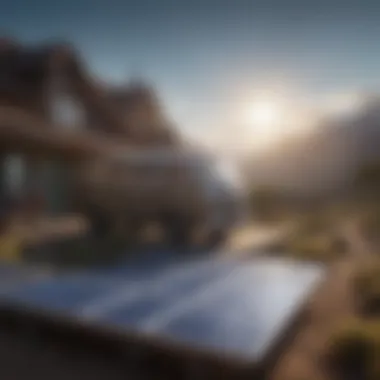Understanding a 3 Kilowatt Solar System: Key Insights


Intro
The shift toward sustainable energy is no longer a trend; it's become a necessity for prudent energy consumers. Among the various options available, a 3 kilowatt solar system stands out as a practical choice, particularly for those navigating the waters of renewable energy for the first time. Understanding how this system operates, its components, and its financial implications can make a world of difference for homeowners and businesses alike. This guide aims to break down the intricacies of the 3 kilowatt solar system, making it accessible for both novices and seasoned investors who are keen on enhancing their financial literacy within the renewable energy sector.
In an increasingly digital world, choosing an effective solar system also means understanding terminology that might sound complex at first but is quite manageable once broken down into bite-sized pieces. Some might feel overwhelmed, yet with the right knowledge at their fingertips, they will find that investing in solar energy can be both feasible and rewarding.
Before diving deeper into the analysis of components, benefits, and the installation process, it’s critical to grasp the language of investment related to solar energy. Let's take a closer look at a few key principles and terms that will come into play as we explore the staggering merits of this renewable energy solution.
Prolusion to Solar Energy Systems
As the world grapples with climate change and rising energy costs, one avenue that continues to gain traction is solar energy. Understanding solar energy systems is not just a niche interest; it has become essential for anyone looking to reduce their carbon footprint or cut energy expenses. This article aims to untangle the complexities of a 3 kilowatt solar system, illuminating its vital components, their benefits, and the myriad considerations involved in its installation and maintenance.
Defining Solar Power Systems
Solar power systems are primarily designed to harness sunlight, converting it into usable electricity. There are various types of solar systems based on their specific applications, with key categories including grid-tied, off-grid, and hybrid systems.
- Grid-tied Systems: These systems are directly connected to the utility grid. They allow homeowners to draw energy when needed and can send excess energy back, often benefiting from net metering, which credits back surplus power to the system owner.
- Off-grid Systems: For those seeking complete energy independence, off-grid systems stand out. They require storage batteries, enabling users to store energy for use when the sun is not shining. This setup is often necessary for remote locations without access to the utility grid.
- Hybrid Systems: Combining the benefits of both grid-tied and off-grid systems, hybrid solar systems are versatile. They can provide energy independence while allowing users to benefit from the grid when it’s convenient.
Understanding these systems sets the foundation for delving deeper into how a 3 kilowatt system specifically fits into the broader solar landscape.
Overview of Kilowatt Systems
Diving into the specifics, a 3 kilowatt system represents a moderate solar solution for small households or businesses. This capacity can greatly contribute to reducing monthly electricity bills and supporting a lower environmental footprint.
A 3 kilowatt system typically features:
- About 10-12 Solar Panels: Glass-faced photovoltaic panels that convert sunlight into electricity.
- Inverter: This component is crucial as it transforms DC (direct current) generated by the panels into AC (alternating current), which is what your home appliances need.
- Mounting Structure: This ensures that panels are positioned at the optimal angle for sunlight absorption.
The benefits of a 3 kilowatt system go beyond financial savings; they also cater to individuals who are environmentally conscious and aspire to contribute to a sustainable energy future. With proper installation and maintenance, such a system can undoubtedly serve as a long-term investment.
By investing in solar, you’re not just saving money; you’re investing in the planet’s future.
Overall, grasping the fundamentals of solar energy systems, particularly the 3 kilowatt configuration, helps users understand their choices in the rapidly evolving renewable energy market. Knowing what options like these entail sets the stage for making informed decisions that align with personal financial goals and sustainability aspirations.
Components of a Kilowatt Solar System
When considering a 3 kilowatt solar system, it's crucial to understand the components that make up this renewable energy solution. Each part plays a significant role in ensuring the effective conversion of sunlight into usable electricity. From solar panels to inverters and mounting systems, familiarity with these elements can help you make informed decisions on installation and maintenance.
Solar Panels: Types and Efficiency
Solar panels are the beating heart of any solar system. They capture sunlight and transform it into electricity. There are primarily two types of solar panels: monocrystalline and polycrystalline.
- Monocrystalline panels are made from single-crystal silicon and are known for their high efficiency. They usually occupy less space since they generate more power per square foot.
- Polycrystalline panels, on the other hand, are made from multiple silicon crystals. These tend to be less expensive but generally have lower efficiency ratings.
When choosing solar panels, it’s essential to consider their efficiency ratings, which indicate how much sunlight they can convert into electricity. Higher efficiency translates into more energy production, impacting the overall performance of your system.
Inverters: Function and Importance
Inverters act as the middleman in a solar energy system. Once solar panels convert sunlight into DC (direct current) electricity, inverters change it into AC (alternating current) electricity, which is what household appliances usually operate on.
There are a few types of inverters:
- String inverters are the most common for residential systems. They connect multiple panels to a single inverter. However, their efficiency might decline if one panel is shaded.
- Microinverters attach to individual panels. This means each panel operates independently, which can optimize energy production, especially if shading is an issue.
The choice of inverter can significantly affect the performance and longevity of the solar system. Good inverters come with warranties lasting from 5 to 25 years.
Mounting Systems and Installation Options
The mounting system is vital for the structural integrity and orientation of the solar panels. Proper installation will ensure that the panels remain effective over their lifespan.


There are several types of mounting systems:
- Fixed mounts keep panels in a single position at an optimal angle for sunlight exposure.
- Adjustable mounts allow for seasonal adjustments to capture sun effectively throughout the year.
- Tracking systems can move with the sun's position and maximize energy capture, although they tend to have higher initial costs.
It's also important to consider whether the panels will be installed on a roof or on the ground, each of which has its own set of challenges and benefits. Factors such as local building codes, structural integrity of your roof, and site elevation can impact installation choices.
"Understanding the components is like having the roadmap for your solar journey. Each piece plays a role in reaching your ultimate destination of energy independence."
Being well-versed in these components not only helps in making a better investment decision, but it also prepares you for what to expect during installation and maintenance. With the right components, your 3 kilowatt solar system can serve you efficiently while reaping the benefits of renewable energy.
Benefits of a Kilowatt Solar System
When it comes to solar energy, the benefits of investing in a 3 kilowatt solar system are both substantial and multifaceted. This level of solar capacity is not just about generating power; it's about creating a lifestyle shift toward sustainability and financial savviness. A 3 kilowatt system can support a significant portion of a household's electricity needs and, in some cases, even lead to surplus energy that can be sold back to the grid. Given the rising costs of conventional energy sources, understanding what a 3 kilowatt solar system can do for homeowners is crucial. Below are some of the main advantages that can draw many towards adopting this technology.
Reduction in Energy Bills
One of the most immediate advantages of installing a 3 kilowatt solar system is the noticeable decrease in electricity bills. When sunlight hits the solar panels, it transforms into energy that homeowners can use right away. This means less reliance on energy providers who tend to charge hefty rates. Many households report savings of 50% or more on their energy bills.
Consider this: if your electricity bill was $200 a month, you might only pay $100 after the installation of a solar system. Over time, these savings can accumulate into significant amounts. Furthermore, by producing your own electricity, you’re somewhat insulated from the fluctuations in energy prices.
"Solar power isn’t just a trend; it’s a long-term investment that pays dividends in lower utility costs."
Here’s a breakdown of how savings can manifest:
- Self-Consumption: Using the generated power for daily needs.
- Net Metering: Selling excess energy back to the grid, receiving credits for energy production.
- Increased Savings Overtime: Reduced utility costs compound, providing more financial freedom.
Environmental Impact
In addition to financial benefits, a 3 kilowatt solar system substantially reduces an individual’s carbon footprint. Traditional energy sources such as coal and gas release significant amounts of greenhouse gases, contributing to climate change. Solar energy, on the other hand, is clean and renewable. By going solar, you’re playing a part in the fight against environmental issues.
Moreover, the installation of solar panels leads to a reduction in air pollutants. With less reliance on fossil fuels, the quality of air improves which is beneficial not just for humans but also for wildlife.
Consider these points:
- Renewable Energy Source: Solar power is sustainable and available in abundance.
- Less Dependence on Fossil Fuels: This shifts energy reliance from non-renewable to renewable resources.
- Community Impact: More homes using solar can prompt local initiatives towards green energy practices.
Increased Property Value
Lastly, installing a 3 kilowatt solar system can considerably increase property value. Homes equipped with solar energy systems often see a return on investment that far outweighs the initial installation cost. Real estate markets are increasingly favoring energy-efficient homes; a survey indicated that homes with solar energy systems sell 20% faster than those without.
Prospective buyers keen on sustainability and lower living costs find properties with solar energy appealing. Even if the house is not up for sale, having a solar system adds to the overall appeal of the property.
Key factors influencing property value include:
- Lower Monthly Bills: Buyers look to save money.
- Tax Benefits: Many regions offer tax breaks for solar installations which can entice buyers.
- Long-Term Savings: Homes with solar systems are often viewed as a smart investment for future homeowners.
As we delve into this topic, it’s evident that the adoption of a 3 kilowatt solar system brings not just personal benefits but also contributes to a sustainable cadre of living. As more homeowners embrace this option, the collective benefits could lead towards a greener future.
Installation Process of a Kilowatt Solar System
When diving into the world of solar energy, the installation process often feels like a mountain to climb. For anyone considering a 3 kilowatt solar system, understanding this process is essential not just for practical purposes but also for making informed decisions. Each step involved contributes significantly to how efficiently the system performs and how satisfactory the overall investment proves to be.
This section highlights three fundamental aspects: assessing energy needs, choosing the right installer, and dealing with permitting and inspection. Each plays a crucial role in setting the stage for a successful installation and maximizing benefits from the solar system.
Assessing Energy Needs
Calculating Peak Power Requirements
Calculating peak power requirements is a pivotal task in the assessment of energy needs. It involves measuring the highest amount of energy that your household consumes at any given time, typically derived from your usage patterns. Imagine it's the hottest day of summer; your air conditioning is cranked up, alongside your refrigerator and perhaps even the washing machine. This is your peak power demand.
This characteristic of peak power calculation isn't just a technicality; it's about ensuring that the system you choose can handle your maximum energy demands without a hitch. Understanding these power requirements influences not just your solar panel selection, but informs your entire system design. A well-calibrated system offers security—knowing your energy needs are covered during peak consumption times can alleviate concerns over potential power outages.


The unique feature of calculating power requirements is its adaptability. Each home is different, and customizing your system can yield many advantages, such as reduced energy bills and improved overall efficiency. However, there's a downside worth considering: underestimating your peak requirements can lead to a system that underperforms when you need it most.
Understanding Local Regulations
This part might not sound particularly thrilling, but understanding local regulations is a must if you're looking to install a solar system. Each region has its own rules regarding solar energy installation, and these regulations can influence everything from system size to installation method.
The crux of the matter lies in the specifics. Local regulations dictate what you can and cannot do. Ignoring them could lead to fines, or worse, a system that doesn't meet legal standards. It also ensures that you're g on the right side of safety protocols, which is a benefit no homeowner should overlook.
A unique feature of understanding these regulations is that it often involves navigating through zoning laws, permitting processes, and even utility requirements. Each layer of compliance might seem daunting but is ultimately designed to protect consumers. On the flip side, it can be time-consuming, adding an extra layer of challenge to your solar journey. Still, successfully adhering to these guidelines sets a solid foundation for a compliant and secure installation.
Choosing the Right Installer
Finding the right installer is akin to choosing the right partner. This professional will carry out the nuts and bolts of your solar system’s installation. They need to possess not only technical savvy but also a reputation for quality. A trusted installer can directly influence the longevity and performance of your system, potentially saving you from unnecessary headaches down the line.
Start by seeking recommendations from friends and family. Online reviews can offer a glimpse into the installer's past projects and client satisfaction. Certifications and experience are paramount; the more experience, the higher the likelihood they’ll know the ropes. An essential characteristic of a good installer is effective communication—make sure they can explain the process in a way that makes sense to you.
Permitting and Inspection
Permitting may sound trivial, yet it's often what separates a smooth installation from a chaotic whirlwind. Essentially, you need permission to install your solar system. This often entails collecting necessary documents, submitting them for approval, and being ready for an inspection once the installation is complete.
Having all the right permits contributes significantly to peace of mind, confirming that your system is up to code and safe for use. More importantly, this process acts as a checkpoint, ensuring everything will function according to local safety and building standards. The downside? Permitting can slow down the installation timeline, something many impatient homeowners might find frustrating.
Financial Considerations
Understanding the financial aspects of a 3 kilowatt solar system is crucial for any potential buyer. Not only does it help in making informed decisions, but it also sheds light on the long-term sustainability of an investment. When you delve into the numbers, you quickly realize that solar systems are more than just an upfront cost; they represent future savings, stability against rising electricity prices, and even potential income from selling excess energy.
Cost Breakdown of a Kilowatt System
Initial Investment
The initial investment in establishing a 3 kilowatt solar system can vary, but it's fundamentally the first step in understanding its financial footprint. This encompasses the cost of solar panels, inverters, mounting systems, and labor for installation. Typically, the upfront expense might range anywhere between six to ten thousand dollars, depending on local pricing and rebates. Key to this investment is that while it might seem hefty at first glance, it's essential to note that this amount is often offset by various incentives that can be available, such as rebates or tax breaks.
One unique feature of this initial expenditure is that many homeowners view it as a long-term asset rather than a mere expense. In essence, they are purchasing not just technology, but energy independence. While some might see it as a burden, others recognize it as a wise financial strategy that pays off in the long run.
Long-Term Savings
When discussing long-term savings, it's important to highlight that these savings come largely from reduced utility bills over the lifespan of the solar system. A 3 kilowatt setup can lead to noticeable decreases in monthly expenses, with many homeowners reporting savings that reach thousands over a decade. In regions where electricity prices rise sharply, the cumulative savings can grow even larger.
Moreover, there's the point about energy efficiency; a well-kept solar system often yields more energy over time, thus enhancing those financial returns. Something else to consider is the impact on home value. Research has shown that homes with solar installations can sell for a premium, meaning that the system not only saves you money but could potentially offer a return during property transactions.
Financing Options
Loans and Leases
Loans and leases represent two popular pathways for financing a solar system. They both offer the chance to make solar energy accessible without having to shell out the full initial investment upfront. A loan allows you to own the system outright after paying it off, potentially leading to greater long-term savings as you will be reaping the benefits of all the energy generated. In contrast, leasing options often provide lower initial costs, which can appeal to those wary of large upfront payments. However, it's essential to note that with leases, you may not qualify for specific tax incentives, which could diminish some financial benefits.
Depending on the type of loan or lease, your decision will hinge on personal preferences and fiscal circumstances. It's worth weighing both sides carefully before making a choice.
Government Incentives
Government incentives play an instrumental role in enhancing the affordability of a 3 kilowatt solar system. These incentives might come in the form of tax credits, rebates, or even grants that aim to motivate homeowners to adopt renewable energy solutions. The Investment Tax Credit (ITC), for instance, allows you to deduct a significant percentage of the investment from your federal taxes. This is a game changer for many homeowners, helping to significantly reduce the cost of solar installation.
Yet, not all government incentives are created equal. Certain programs may vary by state or locality, and diligent research is necessary to understand what is available. Moreover, as regulations evolve, it's crucial to stay abreast of changes that may affect the tax credit percentages or eligibility requirements.
Return on Investment Analysis
Conducting a thorough return on investment (ROI) analysis helps prospective buyers evaluate whether a 3 kilowatt solar system aligns with their financial goals. The ROI considers several factors: the cost of investment against the potential savings on energy bills over time, any incentives received, and the anticipated increase in home value. This multi-faceted approach provides a comprehensive view of the financial viability of solar systems.
When everything is added up—initial costs, savings from energy bills, tax incentives, and increased property value—many find that the ROI tilts in favor of solar systems.
"Investing in solar not only reduces your carbon footprint but also puts money back in your pocket."


In summary, understanding the financial considerations surrounding a 3 kilowatt solar system can empower individuals to make informed decisions, ensuring they reap the benefits of renewable energy in a smart and sustainable way.
Maintenance of a Kilowatt Solar System
Keeping a 3 kilowatt solar system in prime shape isn’t just a good idea; it’s essential. Think of it like taking care of a car; you wouldn’t drive it to the ground without checking the oil. Regular maintenance prolongs the life of your solar system and ensures it runs as efficiently as possible. While solar panels are known for their durability, neglect can lead to minimal issues that, if not caught early, can snowball into costly repairs.
When it comes to solar systems, maintenance can mean the difference between a system that generates power efficiently and one that falls short. Regular upkeep helps in maintaining optimal efficiency, which directly impacts energy savings and return on investment. Moreover, a well-maintained system can serve as a selling point if you decide to move down the line.
Routine Maintenance Tasks
To keep your solar system humming along smoothly, you'll want to adopt a few specific routines. Here are some tasks that can contribute greatly to maintaining peak performance:
- Regular Cleaning: Dust, dirt, and debris can gather on panels, especially in dry areas. Depending on your region, you might need to clean them quarterly or bi-annually.
- Inspection of Connections: Check the electric connections and the inverter regularly. Look for signs of wear or loose connections. If something seems off, get it checked.
- Monitoring Performance: Utilize monitoring tools or apps. Many inverters come with built-in monitoring systems. These tools provide real-time stats and can help spot irregularities in energy production.
- Vegetation Control: Keep an eye on nearby trees or shrubs. As they grow, they may shade your panels, reducing their efficiency. Trimming them back can help.
"A stitch in time saves nine." This old saying rings especially true when it comes to solar maintenance.
- Annual Professional Inspection: It ain’t a bad idea to have a professional take a look once in a while. They can spot issues you might miss and perform any necessary repairs.
By establishing a routine for these tasks, you’ll not only extend the lifespan of your solar system but maximize efficiency, ultimately leading to savings on your utility bills.
Identifying and Addressing Issues
Over time, even a well-maintained system might face certain challenges. Knowing how to identify and address these issues becomes crucial:
- Decreased Energy Output: If you've noticed energy production dipping unexpectedly, it may mean something's awry. Check if dirt, shading, or damage to the panels could be the culprit.
- Inverter Faults: The inverter is a vital part of your system. If it's showing error codes or not functioning, consult the manual. Sometimes, a simple reset can do the trick. However, persistent issues warrant the expertise of a professional.
- Physical Damage: Scan your panels regularly for cracks or other physical damage. Typically, hail or extreme weather can cause this. Any visible damage should prompt an immediate assessment.
- Wiring and Connection Issues: Flickering lights or fluctuating energy usage can hint at problems within the wiring. If symptoms like these pop up, it’s best to engage licensed technicians to avoid fire hazards.
Addressing these problems quickly can save you significant downtime and ensure you are getting the most from your investment.
In summary, maintenance is a big piece of the solar puzzle. Taking ownership of these tasks and staying vigilant will keep your 3 kilowatt solar system operating like a well-oiled machine.
Future of Solar Technology
As the world becomes increasingly aware of environmental issues and the necessity for sustainable energy solutions, the future of solar technology is poised for growth and innovation. This section dives into how this evolution not only affects the solar systems themselves but also influences the broader energy landscape. By understanding what is on the horizon, readers can appreciate both the immediate benefits of a 3-kilowatt system and its potential long-term capabilities.
Emerging Trends in Solar Systems
Recently, several trends have surfaced in the solar industry. Here's a closer look at what to expect in the coming years:
- Increased Efficiency: Emerging photovoltaic technologies are making waves. Innovations like bifacial solar panels, which capture sunlight on both sides, are gaining traction due to their ability to boost energy yield considerably. As new materials are developed, we might see efficiencies surpassing the current standards, making solar systems even more attractive.
- Energy Storage Solutions: The need for reliable energy storage has become paramount. Technologies like lithium-ion batteries are becoming common, allowing homeowners to store excess energy produced during peak sunlight hours. This ensures they can tap into that energy later, especially during nights or cloudy days, optimizing their overall energy consumption.
- Transparent Solar Panels: Imagine using windows as energy producers. Transparent solar technology is being developed that can be integrated into window glass. This could revolutionize urban architecture, enabling buildings to generate electricity without compromising aesthetics.
"These trends not only show the direction of innovation but also how solar technology can integrate into everyday life effectively, leading to broader acceptance and use."
Integration with Smart Home Technology
As technology progresses, smart homes are becoming the norm rather than the exception. Integrating solar systems with smart home technology plays a crucial role in maximizing energy efficiency and enhancing the user experience. Below are a few key aspects of this integration:
- Smart Meters: These devices give real-time data about energy consumption and production. When linked with a solar system, users can monitor their energy usage, tweaking their habits to save costs and energy effectively.
- Home Automation: With systems like Amazon Alexa or Google Home, users can control their solar energy production and consumption through voice commands. For instance, they can schedule appliances or charge electric vehicles when solar production is high, thereby optimizing usage.
- Renewable Energy Management Apps: Various applications allow homeowners to monitor, control, and optimize their solar energy production from their smartphones. They can view energy yields daily, check the health of their panels, and even receive alerts for maintenance needs.
As these technologies continue to evolve, they'll encourage more individuals to transition to solar energy systems, driven by convenience and innovation. The interface between solar and smart home technology signifies a pivotal change in how we harness energy efficiently and responsively.
The End
When examining a 3 kilowatt solar system, it’s essential to recognize the pivotal role it plays not only in reducing electricity bills but also in contributing to a more sustainable future. This article has peeled back the curtain on the many facets of solar energy systems, offering insights into the components and financials involved. The benefits of investing in such a system extend beyond mere numbers; they encompass both environmental and economic dimensions that many homeowners seek to enhance.
Summarizing Key Takeaways
In bringing it all together, here are the key points worth emphasizing:
- Cost Efficiency: The initial investment in a 3 kilowatt solar system can lead to significant savings over time. By understanding cost breakdowns and exploring financing options, homeowners can tailor their approach to fit their budgets.
- Environmental Impact: Switching to solar energy contributes to the reduction of carbon footprints. Every kilowatt produced from renewable sources diminishes reliance on fossil fuels.
- Energy Independence: With solar, homeowners can produce their own power, mitigating the effects of rising utility prices. This independence fosters a more secure energy future.
- Home Value Improvements: Properties equipped with solar panels often see an uptick in market value. Potential buyers are increasingly drawn to homes that offer sustainable energy solutions.
Evaluating Your Investment Decision
Before going full steam ahead with a solar installation, it is vital to take a step back and evaluate whether this investment aligns with your goals. Consider the following:
- Energy Needs: Assess what your energy consumption looks like. Do you have seasonal variations that might affect how much energy you could generate? A precise energy audit can guide decisions.
- Local Conditions: Solar potential varies by location. Factors such as shading from trees or the orientation of your roof can impact the effectiveness of solar panels. Researching local solar energy potential might yield surprising insights.
- Long-Term Commitment: A solar system isn’t just a short-term solution; it’s a long-lasting investment. Determine if you’re prepared for the long haul, factoring in maintenance and potential upgrades as technology evolves.
- Incentives and Rebates: Before diving in, investigate available governmental incentives. Depending on where you live, various programs can reduce initial costs significantly.
Engaging with solar energy is not just about individual benefits but is intricately tied to broader environmental aims. Being informed allows you to not only contribute positively to the planet but also secure your financial future. As the paradigm around energy consumption continues to shift, being proactive in understanding your choices is more critical now than ever.















